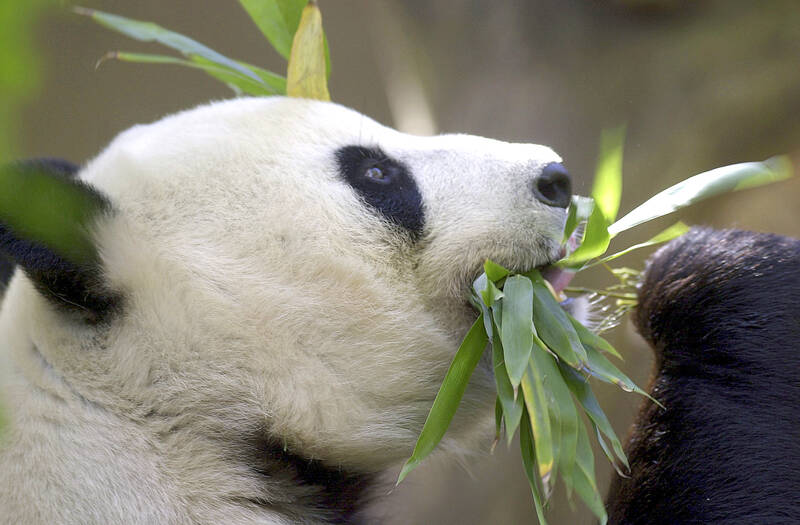China plans to send a new pair of giant pandas to San Diego Zoo, renewing its longstanding gesture of friendship after nearly all the iconic bears on loan to US zoos were returned as relations began to sour between the two nations.
San Diego Zoo officials said that if all permits and other requirements are approved, two bears, a male and a female, are expected to arrive as early as the end of summer, about five years after the zoo sent its last pandas back to China.
“We’re very excited and hopeful,” said Megan Owen of the San Diego Zoo Wildlife Alliance and vice president of Wildlife Conservation Science. “They’ve expressed a tremendous amount of enthusiasm to re-initiate panda cooperation starting with the San Diego Zoo.”

Photo: AP
In November, Chinese President Xi Jinping (習近平) raised hopes his country would start sending pandas to the US again after he and President Joe Biden convened in Northern California for their first face-to-face meeting in a year and pledged to try to reduce tensions.
China is considering a pair that includes a female descendent of Bai Yun and Gao Gao, two of the zoo’s former residents, said Owen, an expert in panda behavior who has worked in San Diego and China.
Bai Yun, who was born in captivity in China, lived at the zoo for more than 20 years and gave birth to six cubs there. She and her son were the zoo’s last pandas and returned to China in 2019.
Gao Gao was born in the wild in China and lived at the San Diego Zoo from 2003 to 2018 before being sent back.
BEAR NECESSITIES
Decades of conservation efforts in the wild and study in captivity saved the giant panda species from extinction, increasing its population from fewer than 1,000 at one time to more than 1,800 in the wild and captivity.
The black-and-white bears have long been the symbol of friendship since Beijing gifted a pair of pandas to the National Zoo in Washington, DC, in 1972, ahead of the normalization of bilateral relations. China later loaned pandas to zoos to help breed cubs and boost the population.
Demands for the return of giant pandas grew among the Chinese public as unproven allegations that US zoos mistreated the pandas flooded Chinese social media.
Fears over the future of so-called panda diplomacy escalated last year when zoos in Memphis, Tennessee, and Washington, DC, returned their pandas to China, leaving only four pandas in the US, all at the zoo in Atlanta. That loan agreement expires later this year.
Many loan agreements were for 10 years and often were extended well beyond. But negotiations last year to extend the agreements with US zoos or send more pandas did not produce results. China watchers speculated that Beijing was gradually pulling its pandas from Western nations due to deteriorating diplomatic relations with the US and other countries.
POLITICAL ANIMALS
Then on Nov. 15, last year, a week after the National Zoo’s pandas departed for China, Xi spoke at a dinner in downtown San Francisco with American business executives and signaled that more pandas might be sent. He said he learned San Diego Zoo and people in California “very much look forward to welcoming pandas back.”
“I was told that many American people, especially children, were really reluctant to say goodbye to the pandas and went to the zoo to see them off,” Xi said.
San Diego Zoo continued to work with their Chinese counterparts even after it no longer had any pandas.
Owen said China is particularly interested in exchanging information on the zoo’s successful breeding of pandas in captivity. Giant pandas are difficult to breed in part because the female’s reproductive window is extremely narrow, lasting only 48 to 72 hours each year.
Bai Yun’s first cub, Hua Mei, was also the first panda born through artificial insemination to survive into adulthood outside of China, and would go on to produce 12 cubs on her own after she was sent to China.
Bai Yun, meanwhile, remained at the zoo where she gave birth to two more females and three males. With cameras in her den, researchers monitored her, contributing to the understanding of maternal care behavior, Owen said.
“We have a lot of institutional knowledge and capacity from our last cooperative agreement, which we will be able to parlay into this next chapter, as well as training the next generation of panda conservationists,” she said.
Chinese experts would travel with the bears and spend months in San Diego, Owen said.
She said the return of the bears is not only good for San Diego but the giant panda’s recovery as a species.
“We do talk about panda diplomacy all the time,” Owen said. “Diplomacy is a critical part of conservation in any number of contexts. ... If we can’t learn to work together, you know, in sometimes difficult situations or situations that are completely out of the control of conservationists, then we’re not going to succeed.”

Last week, the the National Immigration Agency (NIA) told the legislature that more than 10,000 naturalized Taiwanese citizens from the People’s Republic of China (PRC) risked having their citizenship revoked if they failed to provide proof that they had renounced their Chinese household registration within the next three months. Renunciation is required under the Act Governing Relations Between the People of the Taiwan Area and the Mainland Area (臺灣地區與大陸地區人民關係條例), as amended in 2004, though it was only a legal requirement after 2000. Prior to that, it had been only an administrative requirement since the Nationality Act (國籍法) was established in

Three big changes have transformed the landscape of Taiwan’s local patronage factions: Increasing Democratic Progressive Party (DPP) involvement, rising new factions and the Chinese Nationalist Party’s (KMT) significantly weakened control. GREEN FACTIONS It is said that “south of the Zhuoshui River (濁水溪), there is no blue-green divide,” meaning that from Yunlin County south there is no difference between KMT and DPP politicians. This is not always true, but there is more than a grain of truth to it. Traditionally, DPP factions are viewed as national entities, with their primary function to secure plum positions in the party and government. This is not unusual

The other day, a friend decided to playfully name our individual roles within the group: planner, emotional support, and so on. I was the fault-finder — or, as she put it, “the grumpy teenager” — who points out problems, but doesn’t suggest alternatives. She was only kidding around, but she struck at an insecurity I have: that I’m unacceptably, intolerably negative. My first instinct is to stress-test ideas for potential flaws. This critical tendency serves me well professionally, and feels true to who I am. If I don’t enjoy a film, for example, I don’t swallow my opinion. But I sometimes worry

US President Donald Trump’s bid to take back control of the Panama Canal has put his counterpart Jose Raul Mulino in a difficult position and revived fears in the Central American country that US military bases will return. After Trump vowed to reclaim the interoceanic waterway from Chinese influence, US Defense Secretary Pete Hegseth signed an agreement with the Mulino administration last week for the US to deploy troops in areas adjacent to the canal. For more than two decades, after handing over control of the strategically vital waterway to Panama in 1999 and dismantling the bases that protected it, Washington has